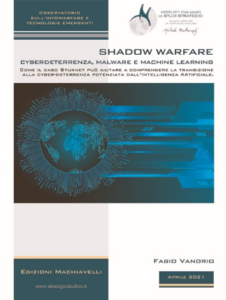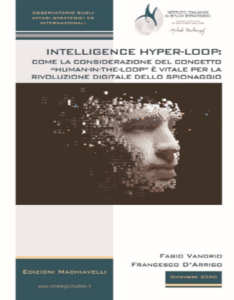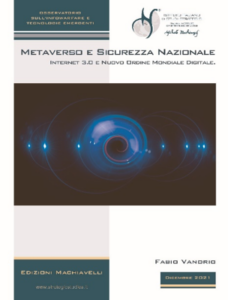How the Fourth Industrial Revolution will change intelligence and national security

The review by Francesco D'Arrigo, director of the Italian Institute of Strategic Studies "Niccolò Machiavelli", of the book "Geopolitics of the infosphere" by Paolo Savona and Fabio Vanorio
Artificial intelligence (AI) is transforming all sectors of society, including the very character of the ongoing global hybrid warfare. Against this, the inability to effectively adopt and integrate AI technology would represent a serious obstacle to national security.
The strategic competitors in the global competition, such as US, UK, China, Russia, France, India Japan are investing heavily in AI especially for national security purposes. However, every civil use is dual-use, and it could not be otherwise as the autonomous evolution of technology is increasingly rapid.
The types of AI used range from predicting mechanical failures in weapon platforms to performing complex analysis in support of war missions. Additional AI capabilities are still under development. These include the analysis of intelligence information (for example, through biometric recognition), the improvement of weapon systems (such as drones and robotic ships), or the use of tactical information on the battlefield (for example, the identification by unmanned weapon systems of targets for missile attacks).
An extremely effective guide in orienting oneself in the delicate relationship between technologies of the Fourth Industrial Revolution and National Security is provided by the excellent new book " Geopolitics of the Infosphere ", written by Paolo Savona, professor of economic intelligence and author of numerous essays on the subject , and Fabio Vanorio, former professor of Economics of National Security in the United States and author of numerous researches also for the Italian Institute of Strategic Studies "Niccolò Machiavelli" , including:
There are three strands explored in the book of importance for national security that I believe should be highlighted as worthy of review:
- the study of the application of the Internet of Things (IoT) to the military sphere;
- the impact of using satellites for Internet coverage in a military conflict;
- Temporal Intelligence.
As for the goal of having Military IoT – “hyperconnected battlefield where Big Data can move seamlessly between air, land, sea, space and cyber forces in real time” (page 207) – the examination offered is of absolute scientific value and not easily found in similar literature, at least at a national level (in particular in Note 8). Also of great importance is the evidence of two problems faced by IoT technology in any operating scenario, one of connectivity (provided by the gap between the available bandwidth and the explosive growth of Big Data, with the consequent acceleration of the availability of 5G networks and 6G), the other decisional (since the exponential growth of the volume of data is saturating the human capacity to monitor it, to analyze it and often also to understand it).
Similarly of enormous importance is the coverage guaranteed by the book on the use of satellites aimed at Internet coverage in a military conflict, the role of Starlink in the Russian-Ukrainian conflict is analyzed, defined by the authors as "the real technological paradigm shift in the military spectrum" (p. 210).
Let's make a summary in order to better understand the problem. In March 2022, Ukrainian forces began using Elon Musk's Starlink network to lead drone-based attacks against Russian positions. On April 27, British freelance journalist David Patrikarakos tweeted an interview with a Ukrainian soldier, Dima, who has been fighting alongside Ukrainian forces since March. Dima stated: “Starlink is what changed the war in favor of Ukraine”, continuing “despite Russian efforts to destroy Ukrainian communication systems, the Starlink network works even under attack by missiles or artillery and it even works in Mariupol”. On June 16, Republicworld.com reported that Starlink satellite technology was helping an elite Ukrainian unit destroy Russian weapons caches.
The unit, according to the Times of London, is Aerorozvidka (literally "aerial reconnaissance"), founded by a group of volunteers passionate about drones and IT in May 2014 in conjunction with the Russian occupation of Crimea and the beginning of war of Donbass, which began as a Ukrainian NGO promoting the creation and deployment of remotely piloted weapon systems in the framework of digital warfare for the Armed Forces of Ukraine, has grown into a unit of the military elite, defined a “war startup” from the Atlantic Council. Their ability to provide C4ISR (Command, Control, Communications, Computers, Intelligence, Surveillance and Reconnaissance) assistance to the Ukrainian Armed Forces, has led to the destruction of several Russian infrastructure, weapons and military units in the occupied territories, drawing the ire of the Kremlin against Elon Mask, accusing him of being a party to the war and forcing him to no longer grant Starlink to Ukraine.
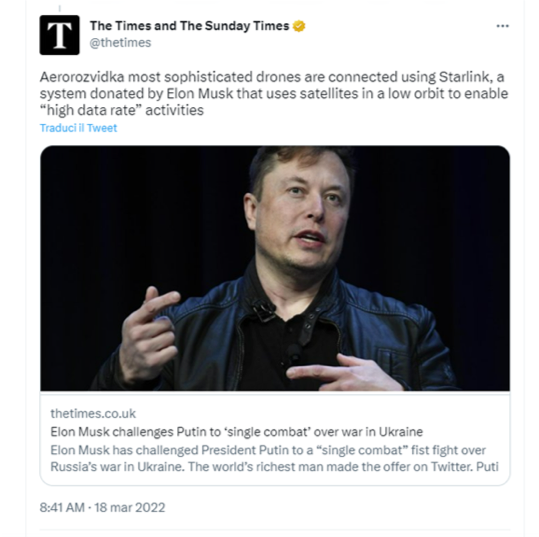
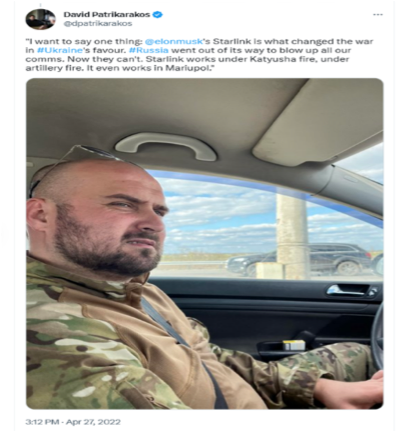
Starlink does not rely on land-based infrastructure and therefore has extremely high military value. As the authors note, “the distinguishing feature of the system is Starlink's deployment of a new generation of low-orbit satellites that are resilient and powerful because they function as a constellation.” (p. 210).
For example, the US military uses Starlink satellite constellations to enhance the communication capabilities of its fighter jets. In March 2022, the Operations Support Squadron of the USAF (US Air Force) 388th Fighter Wing, with assistance from Air Combat Command (ACC) IT teams, one of the USAF's nine Major Commands and primary combat air power for the US Air Force), and the ACC's Agile Battle Labs and Combat Communications initiative (whose role is to improve operational agility in the cyber domain) used Starlink's satellite internet to connect a debriefing facility for the F-35 (hosting an Autonomic Logistics Information System (ALIS) server stack) and to connect to the Air Force's central network entry point for the F-35's supply chain and logistics 35. Tests have found internet speeds up to 30 times faster than current military satellites.
The role played by Starlink in the war between Russia and Ukraine has triggered a chain reaction that can lead to the first war in Space (with consequences that can also be found on the ground, as wars in Space there have already been several without any news ). Starlink's internet services in Ukraine were brought into operation ostensibly to ensure internet access for the population in the face of Russian electromagnetic attacks which knocked out the entire Ukrainian network infrastructure. However, the media later credited Starlink with guiding the Neptune missiles that led to the sinking of the Moskva. A fundamental aspect underlined by the authors is that "unlike traditional high-orbit satellites, which rotate thousands of kilometers above the earth, hover above a point on the ground and transmit radio signals, Starlink's configuration makes it more difficult, if not impossible, taking it offline, because an attacker would have to locate all the satellites, at once, to paralyze the entire system”. (p. 211)
The third aspect that I believe is extremely useful to underline is the reference to Temporal Intelligence (TEMPINT), as defined by the authors "a holistic approach to information gathering that integrates other disciplines through the use of IoT devices" (page 33). TEMPINT is the result of an ongoing transformation in Intelligence collection today essentially based on IoT in all its facets (HumInt, SigInt, MasInt, ImInt), creating a new Intelligence paradigm. We leave to the nostalgics of the Berlin Wall any criticism and invitation to maintain the status quo based on the ability and experience of only human beings. The availability of Big Data today allows analysts to retrace the activity of a target individual and have, for example, information sets relating to where he went, who he spoke with, who wrote, the websites visited, comments posted on the Internet. Images, videos, sounds, IP addresses, geo-spatial positioning, personal, medical, psychological, economic and sensitive information can be traced through IoT devices. As the authors point out, “thanks to digital technologies, partnerships between states and technology companies are enabling forms of selective control and repression thanks to the improvement of information that modifies the general trade-off between repression and co-option, transforming it into a choice between targeted repression and non-exclusive co-optation”. (p. 34)
Additional topics relevant to the topic of national security are dealt with in each chapter (in particular the one relating to quantum computing). Here I decided to offer an overview of what seemed to me truly innovative of a unique book from a scientific and strategic point of view, uncommon in Italy that will fascinate anyone who decides to read it looking for useful ideas for their work or simply to increase their knowledge of knowledge and to be able to face with full knowledge of the facts the challenges and opportunities posed by the Fourth Industrial Revolution.
This is a machine translation from Italian language of a post published on Start Magazine at the URL https://www.startmag.it/innovazione/come-la-quarta-rivoluzione-industriale-cambiera-lintelligence-e-la-sicurezza-nazionale/ on Mon, 10 Apr 2023 11:29:48 +0000.

